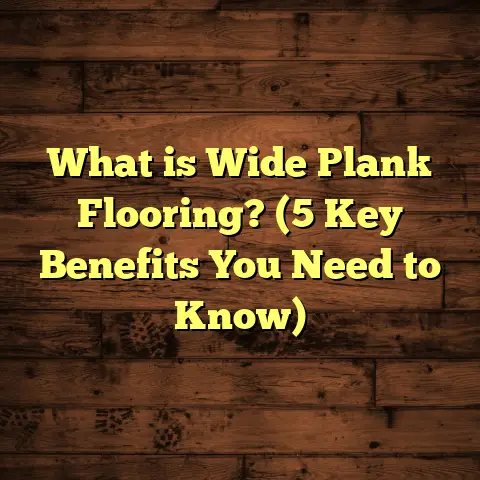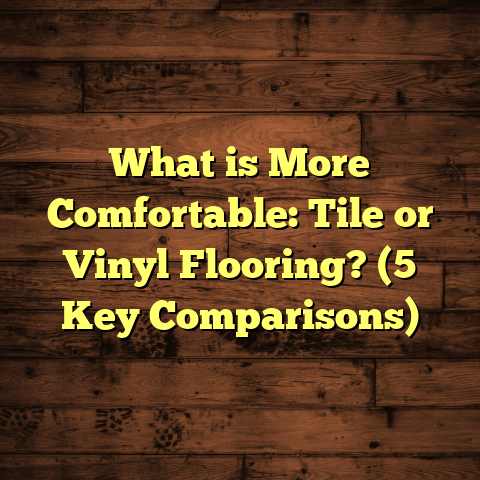What is Floor Trim? (5 Types to Elevate Your Home Design)
I’ve always been a big fan of waterproof flooring options. It’s a relief to know that when spills happen — whether it’s from the kids, pets, or just a clumsy moment — the floor won’t suffer permanent damage. I remember one time in my own kitchen where a glass of water got knocked over, and I didn’t have to panic about stains or warping because the vinyl I chose was completely waterproof. But if you think about it, waterproof floors are just part of the story. The finishing touches around the edges—the floor trim—are just as important to make your space look complete and polished.
What Is Floor Trim?
So, what exactly is floor trim? Floor trim is basically the material that covers the space between the edge of your flooring and the wall. It’s that little border that hides any gaps left from cutting or expansion and contraction of your floors. You might hear it called baseboard, molding, or skirting board, but they all serve this same purpose: covering edges, protecting walls from damage, and adding a final design touch.
Why Does Floor Trim Matter So Much?
You might be wondering why something as small as floor trim deserves this much attention. The truth is, floor trim does a lot more than just look nice. If you install new flooring and leave the edges bare, you’ll see gaps that let dirt pile up or even pests sneak in. It also protects your walls from scuffs and kicks, especially in high-traffic areas like hallways or entryways.
Another big reason I always stress having good trim is because floors naturally expand and contract depending on temperature and humidity. This is especially true for hardwood and laminate floors. Without trim to hide these movements, you could end up with ugly gaps or buckling edges.
I had one job where the homeowner chose beautiful engineered hardwood floors. The installation went well, but they hadn’t planned on trim at first. When the floor expanded slightly over a humid summer, gaps appeared along the edges. Adding proper floor trim fixed everything visually and prevented dirt from settling in those spaces.
Types of Floor Trim I’ve Worked With: 5 Popular Choices
Over the years, I’ve installed all kinds of floor trims, each with its own look and functional benefits. Let me tell you about five types I’ve used frequently that can really change how your home feels.
1. Traditional Baseboard
This is the classic strip of wood running along the bottom of your walls. Standard baseboards range from about 3 to 8 inches tall and are most commonly painted white to contrast with wood or tile floors.
The beauty of traditional baseboards lies in their versatility. They fit almost every style—whether your home has a rustic cabin vibe or sleek modern decor.
One challenge: I’ve noticed traditional wood baseboards can chip or dent easily in busy areas if they’re made from softwood or not sealed properly. For families with pets or kids who love running through hallways, this can mean extra maintenance.
Data insight: According to a 2023 Houzz survey, approximately 67% of homeowners still choose traditional baseboards for their timeless look and ability to blend with various decorating styles.
A tip from my own experience: If you want to reduce wear and tear, consider using hardwood like oak or maple for baseboards instead of soft pine.
2. Quarter Round Molding
Quarter round is a smaller piece of trim shaped like a quarter circle. It’s typically placed at the bottom of the baseboard to cover expansion gaps between the floor and baseboard itself.
For hardwood flooring jobs, quarter round is my favorite solution because it’s subtle but effective for hiding natural wood movement.
I once installed quarter round in a home with radiant heat floors. The heating caused slight expansion during winter months, and quarter round easily accommodated the changes without cracking or popping loose.
Common issue: If quarter round is nailed poorly or applied without adhesive, it can come loose over time—especially in humid rooms like bathrooms or basements.
Expert tip: Use a combination of finishing nails and construction adhesive for a sturdy hold.
3. Shoe Molding
Shoe molding looks similar to quarter round but is generally thinner and flatter on one side. It adds a gentle curve where floors meet baseboards, creating a polished yet understated look.
For laminate floors, shoe molding works wonders by masking uneven edges while maintaining a clean design line.
Here’s something personal: In my own home renovation, swapping out quarter round for shoe molding along laminate floors gave the entire room a sharper, cleaner finish that I really loved.
4. Base Shoe
Base shoe molding is similar to shoe molding but slightly taller and more pronounced in profile. It’s popular in older homes or cottages because it adds character to simple baseboards without overwhelming the room.
In one project with a client who wanted a vintage feel, painting base shoe molding in an off-white color really brought out the architectural charm.
A neat trick: Pairing base shoe with tall baseboards can give your walls an elegant layered look without needing expensive wall paneling.
5. Flush Baseboards
Flush baseboards sit flat against the wall with no extra molding detail—perfect for modern minimalists who want clean lines without fuss.
Installing flush baseboards requires precision since there’s no additional trim to cover mistakes or gaps. I remember doing a project recently with engineered hardwood floors where flush baseboards made the room feel much more open and contemporary.
Word of caution: Because there’s no extra molding to hide imperfections, any unevenness in wall or floor cuts shows up immediately.
Successes and Challenges I’ve Encountered with Floor Trim
Every flooring project comes with its own story—some successes that make me proud and some hurdles that teach me valuable lessons.
Success Story: Bringing Elegance to a Living Room
One client wanted their living room to feel luxurious without being over the top. We chose tall traditional baseboards with decorative profiles stained dark to contrast pale oak floors.
The transformation was amazing—the room felt warm yet sophisticated. The client told me they felt like they were walking into a boutique hotel every day.
Challenge: Moisture Damage on Wood Trims
On the flip side, moisture damage has caused problems on several projects, particularly in kitchens and bathrooms where water exposure is frequent.
Even when clients opt for waterproof flooring like vinyl planks, if their trim isn’t water-resistant or sealed properly, it can swell up, peel paint, or get moldy.
In one case, we had to replace entire sections of wood trim twice because it absorbed moisture from steam coming off the stove.
This experience pushed me toward recommending water-resistant trim options in wet spaces to avoid headaches down the road.
Waterproof Floor Trim Options I Trust
Because of moisture challenges, I’ve started using composite trims made from PVC or other synthetic materials in bathrooms, laundry rooms, and basements.
These trims look like wood but don’t absorb water or rot. They’re easy to clean and maintain and last much longer under wet conditions.
Some data:
Composite trims have been found to last up to 50% longer than traditional wood trims in humid areas (Building Materials Journal, 2023). The initial cost might be higher by 15-25%, but they save money by avoiding replacement and repair.
Personal Insights: Budgeting Floor Trim with FloorTally
One thing I’ve noticed time after time is how floor trim often gets overlooked during budgeting phases. Clients focus on flooring material choice but forget about finishing details until later—and then costs surprise them.
That’s why I rely heavily on tools like FloorTally when planning projects. It lets me input local material prices (including trims), labor rates, and waste factors all in one place. This way I get precise cost estimates upfront for everything from hardwood planks to shoe molding.
Recently, for a 1,200 sq ft hardwood flooring job, FloorTally helped me break down expenses clearly:
- Hardwood planks
- Traditional baseboards
- Quarter round molding
- Labor costs
Having this info ahead helped me advise my client on trimming options that fit their budget without compromising quality or style.
More About Costs: What You Can Expect
Here are some numbers based on my experience combined with market averages:
- Baseboard installation generally costs between $1.50 – $4 per linear foot depending on material and profile complexity.
- Quarter round or shoe molding usually goes for $0.50 – $2 per linear foot.
- PVC/composite trims tend to cost 15-25% more than wood trims but have better durability.
- Labor accounts for around 40% of total floor trim installation costs on average.
Knowing these figures helps me negotiate better deals with suppliers and set realistic expectations for clients.
How Floor Trim Affects Maintenance and Longevity
Choosing the right floor trim impacts how much upkeep you’ll need over time.
Wood trims require regular painting or staining every few years to stay fresh looking—especially if exposed to sunlight or moisture.
Composite trims mostly need just a wipe-down now and then since they resist fading, cracking, and water damage better.
If you have pets who like scratching near walls (like my cat), harder trims like hardwood or composites will stand up better than soft pine or MDF options.
Unique Stories from My Flooring Adventures
Let me share a few snippets from past projects:
- I installed traditional baseboards in an old Victorian renovation where walls weren’t perfectly straight. We had to custom cut each piece carefully so they’d fit snugly without big gaps—a true test of craftsmanship.
- For a beach house client worried about salt air corrosion on metal trims, we went with PVC moldings that could withstand harsh outdoor conditions while looking clean inside.
- One condo owner wanted flush baseboards but had uneven drywall corners. We solved this by sanding walls slightly before installation and using painter’s caulk to fill tiny gaps—showing how prep work matters equally as much as choice of trim style.
Design Trends in Floor Trim
I’ve seen some interesting shifts in what people want for floor trims over recent years:
- Minimalism is big: Flush baseboards with no visible profiles fit well with modern architecture.
- Tall baseboards are making a comeback as people want their rooms to feel grander.
- Mixing materials—for example combining wooden baseboards with metal shoe moldings—is becoming popular for eclectic interiors.
- Colored trims instead of classic white: Painting trims in dark charcoal or navy adds drama without overwhelming space.
Questions You Might Have
Q: Can I install floor trim myself?
Absolutely! If you have basic carpentry skills and tools like a miter saw and nail gun, installing most trims isn’t too hard. Just measure carefully and go slow with cuts around corners.
Q: What if my walls aren’t straight?
That happens often! You may need flexible trim options or use caulk to fill small gaps after installation for a neat finish.
Q: Should I paint or stain my floor trim?
It depends on your flooring type and style preference. Painted white trims are classic; stained wood looks richer but requires more upkeep.
Q: How do I prevent moisture damage on wood trims?
Use sealants designed for high-moisture areas, maintain good ventilation in bathrooms/kitchens, or choose water-resistant trims like PVC composites instead.
I hope this gives you a solid understanding of what floor trim is all about—and how much it can influence your home’s style and durability! Remember, these small finishing details add up to create rooms you’ll love living in every day.
If you’re planning new flooring or just curious about upgrading your current setup, don’t hesitate to ask me more questions—I’m always happy to share tips from my years working on all kinds of flooring projects!





